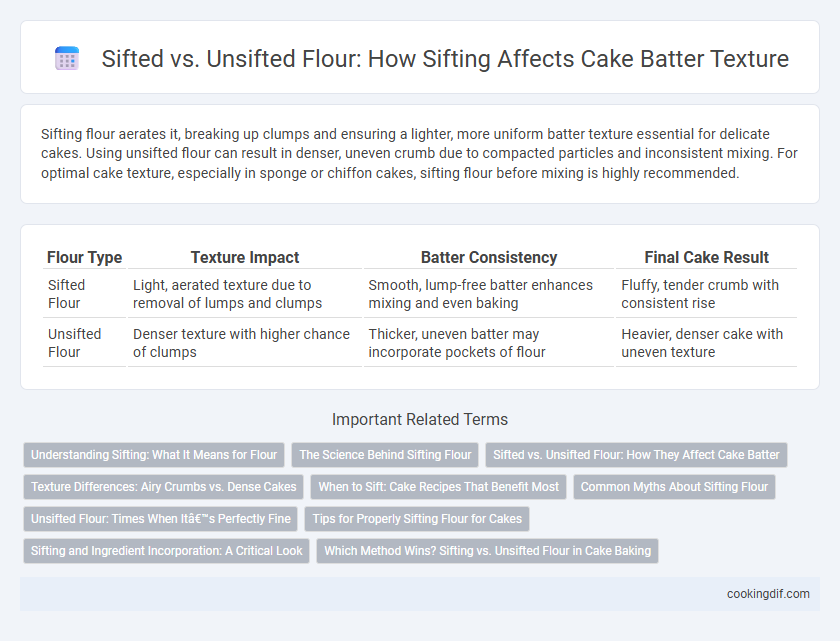Sifting flour aerates it, breaking up clumps and ensuring a lighter, more uniform batter texture essential for delicate cakes. Using unsifted flour can result in denser, uneven crumb due to compacted particles and inconsistent mixing. For optimal cake texture, especially in sponge or chiffon cakes, sifting flour before mixing is highly recommended.
Table of Comparison
| Flour Type | Texture Impact | Batter Consistency | Final Cake Result |
|---|---|---|---|
| Sifted Flour | Light, aerated texture due to removal of lumps and clumps | Smooth, lump-free batter enhances mixing and even baking | Fluffy, tender crumb with consistent rise |
| Unsifted Flour | Denser texture with higher chance of clumps | Thicker, uneven batter may incorporate pockets of flour | Heavier, denser cake with uneven texture |
Understanding Sifting: What It Means for Flour
Sifting flour aerates the particles, breaking up clumps and ensuring a lighter, more uniform batter texture ideal for delicate cakes. Unsifted flour can lead to denser cakes due to uneven distribution and potential lumps in the batter. Understanding sifting enhances baking precision by improving ingredient integration, directly influencing the crumb structure and softness of the final cake.
The Science Behind Sifting Flour
Sifting flour introduces air and breaks up clumps, resulting in a lighter, more uniform batter texture essential for delicate cakes. Unsifted flour can lead to denser, uneven crumb structures due to clumps and inconsistent particle size. Understanding the science behind sifting flour enables bakers to achieve optimal aeration and mixing, crucial for tender, airy cake results.
Sifted vs. Unsifted Flour: How They Affect Cake Batter
Sifted flour incorporates air, resulting in a lighter, more delicate cake batter texture by preventing clumps and promoting even mixing of ingredients. Unsifted flour tends to produce denser batter due to compacted particles, which can lead to a heavier crumb and uneven texture in the final cake. Choosing sifted flour is crucial for recipes requiring a tender, airy consistency and ensures consistent batter hydration and rise.
Texture Differences: Airy Crumbs vs. Dense Cakes
Sifting flour incorporates air, resulting in a lighter, fluffier cake with airy crumbs, while unsifted flour tends to produce denser cakes with tighter crumb structures due to the compacted particles. The aeration from sifting enhances the batter's ability to trap gas during baking, significantly improving volume and tenderness. Choosing sifted flour is essential for delicate cakes requiring a soft, open crumb texture, whereas unsifted flour suits recipes needing a sturdier, compact crumb.
When to Sift: Cake Recipes That Benefit Most
Sifting flour aerates the particles, resulting in lighter batter textures particularly crucial for delicate cakes like chiffon, sponge, and angel food. Recipes requiring precise measurements and even distribution of leavening agents, such as layered butter cakes and genoise, benefit significantly from sifted flour to avoid dense or uneven crumb structures. Dense cakes like pound cake or banana bread typically perform well with unsifted flour, preserving moisture and achieving a heartier texture.
Common Myths About Sifting Flour
Sifting flour is often believed to be essential for making cakes light and fluffy, but many professional bakers agree that sifting primarily helps to aerate the flour and remove lumps rather than drastically changing the texture. Unsifted flour can produce equally tender cakes if properly measured and mixed, as over-sifting can sometimes incorporate too much air, leading to a denser crumb. Understanding that sifting is a technique for consistency rather than a strict requirement allows bakers to focus on accurate measuring and gentle mixing to achieve ideal batter texture.
Unsifted Flour: Times When It’s Perfectly Fine
Using unsifted flour in cake batter maintains a denser texture, which is ideal for rich, moist cakes like pound cakes and fruitcakes. Unsifted flour retains its natural moisture and weight, ensuring better structure and a more substantial crumb. When the recipe calls for minimal aeration or relies on other leavening agents, unsifted flour delivers perfectly fine results without compromising quality.
Tips for Properly Sifting Flour for Cakes
Using sifted flour in cake batter enhances aeration and prevents clumps, leading to a lighter, fluffier texture. To properly sift flour, use a fine-mesh sieve and gently tap or shake it over a mixing bowl, ensuring even distribution without compacting the flour. For best results, sift flour with other dry ingredients like baking powder or cocoa powder to create a uniform mixture that promotes consistent baking and tender crumb structure.
Sifting and Ingredient Incorporation: A Critical Look
Sifting flour aerates it, breaking up clumps and ensuring even distribution of leavening agents, which results in a lighter, more uniform cake texture. Properly sifted flour enhances ingredient incorporation by allowing better mixing with wet ingredients, reducing the risk of dense or uneven batter. Skipping sifting can lead to uneven texture and inconsistent rise, impacting the overall quality of the cake crumb.
Which Method Wins? Sifting vs. Unsifted Flour in Cake Baking
Sifting flour aerates and removes lumps, resulting in a lighter, more tender cake crumb and improved batter consistency. Unsifted flour can still produce good cakes but may lead to denser texture and uneven mixing. For optimal cake texture, sifting flour is the preferred method to ensure even distribution of dry ingredients and enhanced rise.
Sifting vs Unsifted Flours for batter texture Infographic

 cookingdif.com
cookingdif.com